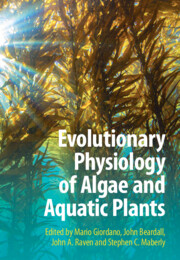Book contents
- Evolutionary Physiology of Algae and Aquatic Plants
- Evolutionary Physiology of Algae and Aquatic Plants
- Copyright page
- Contents
- Contributors
- Preface
- Acknowledgments
- 1 Environmental Changes Impacting on, and Caused by, the Evolution of Photosynthetic Organisms
- Part I Origins and Consequences of Early Photosynthetic Organisms
- Part II Physiology of Photosynthetic Autotrophs in Present-Day Environments
- 7 Light as a Major Driver of Algal Physiology and Evolution
- 8 Temperature: Still an Enigmatic Driver in the Evolution and Physiology of Algae
- 9 Nutrient Acquisition by Algae and Aquatic Embryophytes
- 10 Salinity
- 11 Desiccation
- 12 Trait Trade-Offs in Mixoplankton: An Analysis
- 13 Effects of Pollutants on Microalgae
- 14 Algae in Extreme and Unusual Environments
- Part III The Future
- Index
- References
7 - Light as a Major Driver of Algal Physiology and Evolution
from Part II - Physiology of Photosynthetic Autotrophs in Present-Day Environments
Published online by Cambridge University Press: 24 October 2024
- Evolutionary Physiology of Algae and Aquatic Plants
- Evolutionary Physiology of Algae and Aquatic Plants
- Copyright page
- Contents
- Contributors
- Preface
- Acknowledgments
- 1 Environmental Changes Impacting on, and Caused by, the Evolution of Photosynthetic Organisms
- Part I Origins and Consequences of Early Photosynthetic Organisms
- Part II Physiology of Photosynthetic Autotrophs in Present-Day Environments
- 7 Light as a Major Driver of Algal Physiology and Evolution
- 8 Temperature: Still an Enigmatic Driver in the Evolution and Physiology of Algae
- 9 Nutrient Acquisition by Algae and Aquatic Embryophytes
- 10 Salinity
- 11 Desiccation
- 12 Trait Trade-Offs in Mixoplankton: An Analysis
- 13 Effects of Pollutants on Microalgae
- 14 Algae in Extreme and Unusual Environments
- Part III The Future
- Index
- References
Summary
Solar radiation is the major factor shaping the environment where algae, cyanobacteria and aquatic macrophytes can thrive. Light is the energy source for photosynthesis and growth and can control algal net primary production. Changes in light intensity occur on orders of magnitude within timescales from milliseconds to hours, seasons and even eons. In water, light is exponentially attenuated with depth, with attenuation being wavelength dependent. As a result, the intensity and spectrum of available light can be very dynamic and unpredictable. To cope with such a challenging environment, an array of sensing and feedback-loop mechanisms has evolved in aquatic phototrophs. The structural and functional plasticity of light harvesting and photoprotection mechanisms is also extremely high. This has allowed algae to occur, thrive and evolve in all niches where light is available.
Keywords
- Type
- Chapter
- Information
- Evolutionary Physiology of Algae and Aquatic Plants , pp. 115 - 135Publisher: Cambridge University PressPrint publication year: 2024

